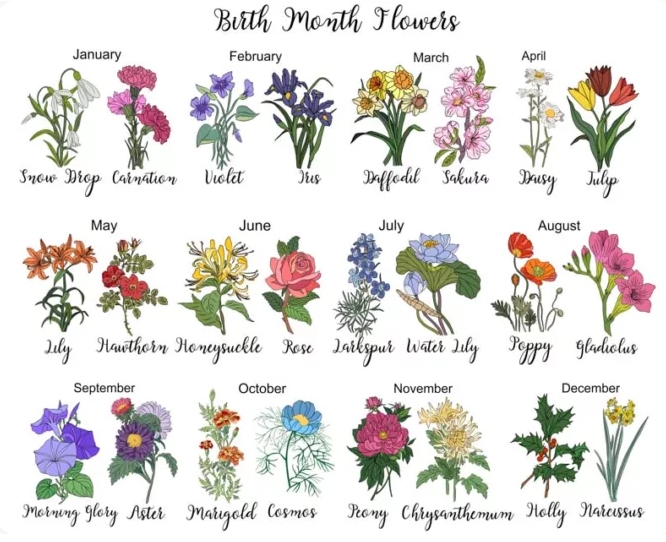Chrysanthemums and Peonies are the birth flowers for November. The chrysanthemum—or mum for short—is the flower most associated with the fall season, providing the last pop of color in the garden. They make excellent decorations for autumn displays and have a long history of symbolism dating back centuries. Learn more about these two flowers!
Chrysanthemums, commonly known as "mums," are perennial plants famous for their brightly colored, showy flowers. Chrysanthemums symbolize friendship, love, and joy, capturing the warm and sociable nature of people born in November.
Peonies, scientifically known as Paeonia, are a beloved flowering plant famous for their large, lush, and fragrant blooms.

Native to Asia, the word chrysanthemum comes from the Greek prefixes chrysos, meaning “gold,” and anthemon, meaning “flower.” Swedish botanist Carl Linnaeus is said to have named the plant.
The original color of the chrysanthemum was golden, but through cultivation, the flower now comes in a range of colors—yellow, orange, white, purple, pink, and red. A member of the daisy family (Asteraceae), the chrysanthemum is one of the most widely cultivated flowers.
Chrysanthemums symbolize loyalty, friendship, and joy, but each color conveys a specific meaning. For example, red represents true love, white signifies innocence and honesty, and yellow symbolizes a wounded heart or neglected love.
In parts of Europe, the chrysanthemum is seen as an expression of sorrow and a symbol of death and mourning.
The Chinese and Japanese view the chrysanthemum as a sign of youth. It was believed to allow people to live longer and keep their bodies healthier. According to folklore, one chrysanthemum petal at the bottom of a glass of wine would promote longevity.
According to Chinese tradition, the flower prevents gray hair.
Learn more about the meaning of flowers!
The chrysanthemum dates back to the 15th century B.C. in China, where it was grown as a flowering herb and used in salads and teas. In Chinese art, the chrysanthemum is one of the four plants that make up the Four Gentlemen, representing the four seasons, along with the plum blossom, the orchid, and the bamboo. It has been used in China for a long time as a remedy for headaches, to reduce blood pressure, and as an anti-inflammatory. It has also been offered to the elderly as a symbol of long life and good luck.
By the 17th century, chrysanthemums were introduced to Europe and then the United States.
It is the national flower of Japan, and each year, the Festival of Happiness is held on September 9 to celebrate the chrysanthemum. It has long represented royalty and nobleness in Japan and is used on the emperor’s official seal and crest.
The chrysanthemum is the flower given for a 13th anniversary and a traditional flower given on Mother’s Day in Australia. It is the official flower of Chicago, Illinois, too.
The National Chrysanthemum Society was incorporated as a nonprofit in 1954. Since then, the society has created a classification system—13 groups in all—for the diverse blooms.
Mums can be grown from seeds, cuttings, or by division. They are easy perennials to grow, and they should be planted in early spring after the possibility of frost has passed. They can be planted at any time but need at least six weeks for their roots to establish before hot temperatures or freezing weather. The plants will grow in the spring and summer but will not flower until fall.
Mums should not be planted in the same area for more than three years in a row—this practice will prevent diseases and pests.
When frost has killed the foliage, cut it back to the ground and cover it with mulch.

Captivate visitors and neighbors with the loveliness of Peonies. Our peony plants are gorgeous perennials that are famous for their spectacular blooms, beautiful greenery, and rich fragrance. Available in a variety of red, white and pastel shades, our peony flowers feature an abundance of big, sumptuous petals that bloom amid luxuriant deep green foliage in a much-anticipated summer spectacle.
Peonies symbolise bashfulness due to the Greek myth of Paeonia, evolving into beliefs of curses for digging them up or having bad luck if they dry out. So, do not miss any of these peony care tips to ensure they last! In China and Japan, peonies mean ‘king of flowers’, and are used in important holidays like Chinese New Year. They are also known to symbolise wealth, because for a really long time only Chinese emperors used peonies. In Japan, they represent bravery, honour and good fortune.
Generally, though, peonies symbolise prosperity, good luck, love and honour. So, whether you know someone who’s getting married, graduating or recently gave birth, send them a pretty peony bouquet.
Peonies date back to 1000 BC, a staggering 4000 years ago! They first appeared in Chinese gardens and reached Japan, who are now major players in producing peonies, by the 8th century. The peony flower was mainly used as a medicine to treat things like headaches and asthma or even to relieve childbirth pain. (We’ll probably stick to more modern pain relief options for that one!)
They were brought over to Europe in the late 1800s and were, understandably, a huge hit. And used for gardens right away all over Europe, North America and beyond!
There’s actually a couple of theories on how peonies got their name. One comes from Greek Mythology where Paeon extracted a milky liquid from the peony root and cured Pluto. This caused the green monster to rear its ugly head in the god of medicine. Zeus ended up saving Paeon by turning him into...you guessed it...the peony flower.
The second story on how the peony got its name comes from another Greek myth. This time, Apollo was caught being a bit naughty and flirting with a nymph named Paeonia, behind Aphrodite’s back. Of course, Aphrodite got a little bit upset by this and turned the nymph into a peony.
Remarkably easy to care for, peonies are grown from tubers planted 2 inches deep and 3 to 4 feet apart in well-drained soil. Peony bulbs and roots grow best in hardiness zones 3-8 with full to part sun. They thrive in zones 3 through 8 in full to part sun, and they grow up to 3 feet tall with magnificent 5- to 7-inch blooms. These stunning yet hardy plants don't mind chilly winters, rarely need fertilizer and are resistant to deer and disease. They occasionally require staking, because the big, heavy flowers sometimes weigh down their stems. Although dividing is not necessary, it is possible to divide peonies plants and share them. Because these hardy perennials can live as long as 100 years, peony plants may be passed down through several generations.
Shiny, attractive leaves stay green long after the peonies' flowers have gone, so they are well-suited for borders or walkways, especially in places where their fragrance may be enjoyed by passersby. Elegant and stately standing alone, they can be truly spectacular mixed with other varieties. Soft, pink peonies are a brilliant match to varieties with fully double white blooms. Or complement red and pink cultivars with bi-coloured peonies. Layers of pink and white resemble a creamy parfait, while yellow and white bi-colours lend a cheery air. Peonies also make lovely companions to roses of any colour. They are outstanding as cut flowers and are favorites for elegant bridal bouquets. Choose these splendid flowers for your garden and you'll enjoy their colour, charm and sweet aromas for many years to come.




